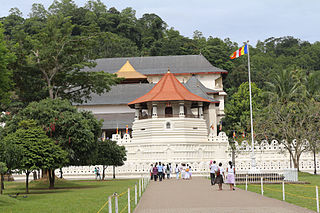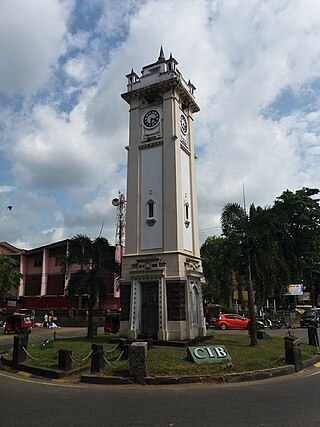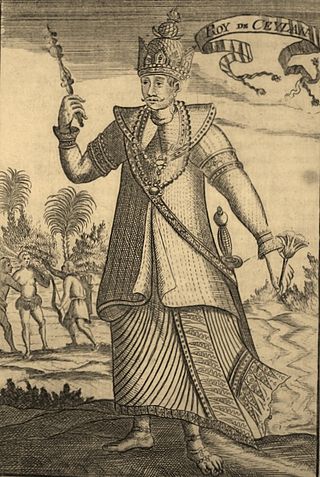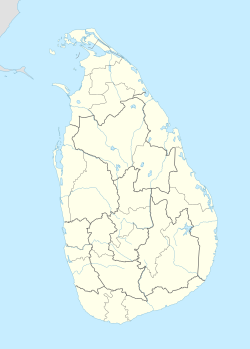History
The name of the town is purportedly derived from Sangaruwan Ketha, a thriving paddy field. The location was also known as Diyatillakepura, a camping site of a number of Kings of Kandy during the various Chola invasions. Hanguranketha was used on numerous occasions as the temporary capital of the Kingdom of Kandy
King Senarath was the first king to build a royal palace in Hanguranketha.
His son, King Rajasinghe II, erected a royal palace, audience hall and several other buildings in Hanguranketha, as well as a constructing a lake, Udamaluwa, making it the site of his summer palace. According to Robert Knox's An Historical Relation of the Island Ceylon , the city had been surrounded by a whitewashed protective wall, which encircled the large two-storied palaces. The entrance of the palace had two beautifully carved doors and door panels. Rajasinghe was cremated at Hanguranketha following his death in 1687 and his ashes were deposited at a site near Adahanamaluwa Gedige Viharaya.
In 1814 King Sri Vikrama Rajasinha fled to the safety of Hanguranketha when the Sinhalese aristocracy torched his palace in Kandy.
The palace was completely destroyed in the Uwa Wellassa Great Rebellion in 1818. Only two buildings still exist from that era, the Maha Vishnu Devalaya and the Pothgul Maliga Maha Viharaya. Following the 1818 Rebellion, the remains of the destroyed palace were used in the construction of the present Viharaya, with a large hall for the library built during 1831-1880. The stone carved door frames, moon-stone slab and stone pillars belonging to the royal palace have been incorporated into the Viharaya building. The Devalaya was used as a troop garrison by the British following the rebellion.

Kandy is a major city in located in the Central Province of Sri Lanka. It was the last capital of the Sinhalese monarchy from 1469 to 1818, under the Kingdom of Kandy. The city is situated in the midst of hills in the Kandy plateau, which crosses an area of tropical plantations, mainly tea. Kandy is both an administrative and religious city and the capital of the Central Province. Kandy is the home of the Temple of the Tooth Relic, one of the most sacred places of worship in the Buddhist world. It was declared a World Heritage Site by UNESCO in 1988. Historically the local Buddhist rulers resisted Portuguese, Dutch, and British colonial expansion and occupation.

The Kandyan Wars refers generally to the period of warfare between the British colonial forces and the Kingdom of Kandy, on the island of what is now Sri Lanka, between 1796 and 1818. More specifically it is used to describe the expeditionary campaigns of the British Army in the Kingdom of Kandy in 1803 and 1815.

Kegalle is a large town in Sabaragamuwa Province of Sri Lanka. It is located on the Colombo–Kandy road, approximately 78 km (48 mi) from Colombo, 40 km (25 mi) from Kandy, 32 km (20 mi) from Kurunegala and 46 km (29 mi) from Avissavella. It is the main town in the Kegalle District, which is one of two districts which comprise Sabaragamuwa Province. The town is governed by an Urban Council.

Kurunegala is a major city in Sri Lanka. It is the capital city of the North Western Province and the Kurunegala District. Kurunegala was an ancient royal capital for 50 years, from the end of the 13th century to the start of the 14th century. It is at the junction of several main roads linking to other important parts of the country. It is about 94 kilometres (58 mi) from Colombo, 42 kilometres (26 mi) from Kandy and 51 kilometres (32 mi) from Matale.

Ratnapura is a major city in Sri Lanka. It is the capital city of Sabaragamuwa Province, as well as the Ratnapura District, and is a traditional centre for the Sri Lankan gem trade. It is located on the Kalu Ganga in south-central Sri Lanka, some 101 km (63 mi) southeast of the country's capital, Colombo. Ratnapura is also spelled as Rathnapura.

The Kingdom of Kandy was a monarchy on the island of Sri Lanka, located in the central and eastern portion of the island. It was founded in the late 15th century and endured until the early 19th century.

Vimaladharmasūriya I was a king of Kandy from 1590 to 1604. His reputation was built when he successfully repulsed two major Portuguese offensives on Kandy, the Battle of Danture in 1594 and the Battle of Balana in 1602, in both of which the Portuguese were humiliatingly defeated.

Rajapaksa Wickramasekera Mudiyanselage Bandaranayake Monarawila Keppetipola, more widely known as Keppetipola Disawe was a Disawe, a high-ranking official under the rule of King Sri Wikrama Rajasinghe and later under the British Administration in Sri Lanka. He was a prominent leader of the Uva rebellion of 1818 after he joined the rebels whom he was sent to suppress by the British. The rebellion was defeated by the British, and Keppetipola Disawe along with several other leaders of the rebellion were found guilty of high treason and sentenced to death. He is well known for the exceptional courage that he showed at the moment of his execution and is now a national hero of Sri Lanka.

The Royal Palace of Kandy, situated in Kandy, Sri Lanka, is a historical complex that served as the official residence for the monarchs of the Kingdom of Kandy until the advent of British colonial rule in 1815. It is noteworthy for its adherence to traditional Kandyan architectural styles, the buildings within the palace complex contains well-preserved examples of intricate woodwork, finely crafted stone carvings, and ornate wall murals. This complex encompasses a range of structures, including the Audience Hall, the Queen's Palace, the King's Palace, and the Temple of the Tooth Relic, a venerated Buddhist temple with global significance. Both the palace complex and the Temple of the Tooth are recognised as UNESCO World Heritage Sites.

The Kingdom of Kotte, named after its capital, Kotte, was a Sinhalese kingdom that flourished in Sri Lanka during the 15th century.

Upulvan, also known as Vishnu is a guardian deity of Sri Lanka. Sri Lankan Buddhists believe him also as a protector of the Buddhism in the country. The name Upulvan depicts his body colour which means "blue water lily coloured". The cult of Upulvan started during the medieval period in Sri Lanka. According to the local lore and legend, Upulvan is the god whom the Buddha entrusted with the guardianship of Sri Lanka and Buddha Śāsana of the country.

Ridi Viharaya or Silver Temple is a 2nd-century BCE Theravada Buddhist temple in the village of Ridigama, Sri Lanka. Built during the reign of Dutthagamani of Anuradhapura, the temple is considered as the place where the silver ore, which provided silver to complete Ruwanwelisaya; one of the largest stupa in Sri Lanka, was discovered. According to the chronicles Mahavamsa and Thupavamsa, the Ridi Viharaya complex was built in gratitude for helping him cherish his dream of completing Ruwanwelisaya.

Ehelapola Wijesundara Wickramasinghe Chandrasekara Seneviratna Jayatillake Ekanayaka Amarakone Wahala Panditha Mudiyanse, commonly known as Ehelapola Nilame, was a courtier of the Kingdom of Kandy. He was the Pallegampahe Adigar, and held the honorary title of Maha Nilame from 1811 to 1814 under the reign of Sri Vikrama Rajasinha of Kandy. Ehelapola joined a revolt against King Rajasinha in Sabaragamuva province after he was sent to conquer it, and his entire family was executed. He helped the British launch an invasion against the Kandy Kingdom, overthrow Rajasinha, and subjugate Kandy to the British monarchy under the Kandyan Convention. Various records of Sri Lankan history suggest that he aided the British with the plan to later overthrow them. He was later convicted of treason by the British following the Great Rebellion of 1817–18, and was exiled to Mauritius.
Kundasale is a former town, now a suburb of Kandy in Kandy District, Central Province of Sri Lanka. The town is situated 7 km (4.3 mi) to the southeast of the centre of Kandy. The population is about 150,000.
Ratnapura Portuguese fort was built by the Portuguese in Ratnapura, Sri Lanka.

Maha Saman Devalaya or the Great Saman Temple is a shrine dedicated to deity Saman, situated at Ratnapura, Sri Lanka who is the presiding deity of the Sri Pada Mountain which is also called Samanthakuta meaning the mountain of Saman which is believed to have the left foot impression of Buddha which he kept in his visit to Sri Lanka.

Kotte Raja Maha Vihara is a historic Buddhist temple situated in Sri Jayawardenepura Kotte, Western province, Sri Lanka. It is located near to the historic building Pita Kotte Gal Ambalama at the Pita Kotte junction on Kotte road. The temple has been formally recognised by the Government as an archaeological site in Sri Lanka. The designation was declared on 17 May 2013 under the government Gazette number 1811.

Tempita Vihara is a unique type of image house found in some Buddhist temples in Sri Lanka. With an inimitable architecture design, Tempita Viharas were a popular aspect of many Buddhist temples during the 17th to 19th centuries. Construction of Tempita Viharas in or after the 20th century has been not recorded. More than two hundred Tempita Viharas have been identified in Sri Lanka to date. Most of the shrines are found in North Western, Sabaragamuwa, Central and Western provinces.
Asgiri Maha Viharaya is a Buddhist monastery located in Kandy, Sri Lanka. It is the headquarters of the Asgiriya chapter of Siyam Nikaya, one of the two Buddhist monasteries that holds the custodianship of sacred tooth relic of Buddha kept in Sri Dalada Maligawa, Kandy. The chief incumbent of the Asgiri Maha Viharaya is the Mahanayaka thero of Asgiri chapter of Siyam nikaya, a leading Buddhist monastic fraternity in Sri Lanka. The present chief incumbent of Asgiri Maha Viharaya is Warakagoda Sri Gnanarathana Thero. Asgiri Maha Vihara traces its origin from the Wanavasi sect of the Dimbulagala forest monastery of Polonnaruva. Currently, 565 Buddhist temples in Sri Lanka function under Asgiri Viharaya of Kandy.

The Kandyan period covers the history of Sri Lanka from 1597–1815. After the fall of the Kingdom of Kotte, the Kandyan Kingdom was the last Independent monarchy of Sri Lanka. The Kingdom played a major role throughout the history of Sri Lanka. It was founded in 1476. The kingdom located in the central part of Sri Lanka managed to remain independent from both the Portuguese and Dutch rule who controlled coastal parts of Sri Lanka; however, it was colonised by the British in 1815.

















